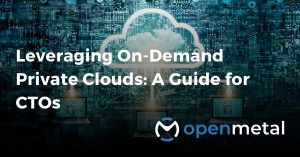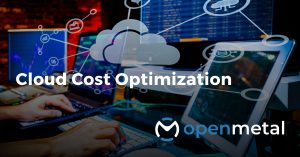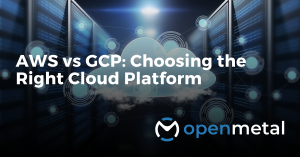What is a cloud?
A cloud is a network of remote servers and data storage systems that are accessed through the internet. These servers and data centers can be owned by your organization (On-Prem) or hosted and maintained by cloud providers like OpenMetal. Using cloud infrastructure will allow your organization to store and manage data, run applications like commercial property management software, and access computing resources.
The cloud offers a dynamic and scalable environment, which allows organizations to readily adjust their computing resources to match the ever-changing demands of their business. Depending on your workload size and your cloud provider, cloud services can be budget-friendly. Many providers offer a pay-as-you-go or subscription model, which significantly reduces capital expenses related to physical hardware and data centers. Clouds can be accessible from anywhere with an internet connection, which fosters remote work and collaboration among geographically dispersed teams. Cloud computing can simplify data backup and disaster recovery, allowing for a cost effective way for organizations to have multi region redundancy or have storage blocks to back up data. In addition to multi- region redundancy, some regions such as the European Union require that data is stored within its borders. Organizations can easily extend services to international customers by accessing clouds housed in local data centers by cloud providers.
However, it is important for organizations to assess their specific needs, consider potential challenges, and formulate a comprehensive cloud strategy. When building a cloud strategy, organizations should keep in mind that not all workloads or data are suitable for the cloud, and careful attention should be given to security, compliance, and data governance requirements.
Let’s explore the various cloud models and see which solutions may best suit your organization’s needs.
Understanding On-Premise (On-Prem) clouds:
An “on-premises cloud” or traditional private cloud is a cloud computing environment that an organization builds and manages for themselves within its own physical data centers. On-Prem cloud solutions offer the benefits of cloud computing while maintaining control and security. On-Prem has evolved into a colocation, organizations seeking to build their private data centers no longer need to having their own building, they can rent colocation space within an existing data center. Colocation space significantly reduces the real estate, building customization and physical security costs that an organizations seeking to have a private cloud will incurr.
Key characteristics of on-premises or private clouds:
- Location: Private clouds are hosted on the organization’s own hardware and data centers.
- Isolation: Private clouds are dedicated to a single organization, providing greater control and security over the infrastructure.
- Customization: Organizations can tailor the private cloud environment to their specific needs, including hardware, software, and security configurations.
- Control: Private clouds offer more control over data, compliance, and security.
- Security and Compliance: Private clouds are often chosen by organizations with strict security and compliance requirements, such as those in heavily regulated industries like finance and healthcare.
- Cost: Setting up and maintaining a private cloud can be costly in terms of capital expenditures for hardware, engineering time and ongoing operational expenses.
- Responsibility: Organizations are responsible for managing, maintaining and advancing their private cloud infrastructure.
Before an organization commits to an on-premise solution, there are several factors it should carefully consider.
- Firstly, building and maintaining a private cloud infrastructure can be significantly more expensive and resource-intensive than leveraging public cloud services.
- Secondly, on-premises clouds may lack the flexibility and agility that public cloud platforms offer. Building a cloud takes months, even if your team has the skills to build a cloud, it takes time to acquire hardware and set up each cloud. Making the process to scale slow. If you are in an industry with unpredictable peaks in workloads and need to scale on-demand, this is not the solution for you.
- Lastly, the burden of maintaining and upgrading on-premises hardware and software can divert resources and attention away from an organization’s core mission. Unless you can afford talent dedicated to maintaining your infrastructure, your engineering team will be stretched thin between multiple functions leading to delays and inefficiencies.
What is Public Cloud?
In contrast to On-Prem private clouds, there are public clouds. Public clouds are built and maintained by third party cloud providers such as AWS, GCP, etc. With public cloud, the hardware is hosted in the cloud provider’s data center and the user has no responsibility for hardware or software maintenance and updates of the cloud. Public cloud provides computing resources, infrastructure, and services over the internet to multiple users and organizations. Public cloud services are accessible to anyone, featuring shared infrastructure that enables cost-effective resource pooling, scalability for fluctuating workloads, self-service provisioning, pay-as-you-go billing, and a wide array of managed services and tools. One of the biggest advantages of public cloud is the low cost to get started on the cloud. You do not have to invest in costly hardware or rent the entire hardware, this makes public cloud ideal for small workloads. Another advantage of the public cloud is that organizations can have their workloads hosted in data centers globally, as many cloud providers have data centers in multiple geographic regions.
Here are some key characteristics and features of public cloud computing:
- On-Demand Service: You can access resources almost instantaneously. Cloud services are typically available on a pay-as-you-go or subscription basis, allowing users to scale resources up or down as needed.
- Broad Network Access: Cloud services are accessible over the internet allowing for anywhere and any device.
- Resource Pooling: Cloud providers pool computing resources (e.g., servers, storage, and networking) to serve multiple customers. Resources are dynamically allocated based on demand.
- Rapid Elasticity: Users can quickly scale resources to accommodate changing workloads, often with minimal manual intervention.
- Self-Service: Users can provision and manage resources through web interfaces or APIs without requiring direct intervention from the cloud provider.
- Measured Service: Usage of cloud resources is metered, and users are billed based on the resources they consume.
With public clouds, the term cloud is loosely used. Users do not have exclusive rights to the hardware, many clouds are shared by various users who have access to a virtual machine or virtual private cloud (subsections of a cloud) rather than an entire cloud. This limits the functionality of the cloud to a one size fits most structure and users are limited when it comes to fine tuning their virtual environments to meet their workloads. Organizations in certain industries and organizations with highly sensitive or regulated data may prefer to maintain strict control over their infrastructure to mitigate potential security and compliance risks. Additionally, with public cloud is it easy to consume resources beyond your budget, leaving organizations scrambling to mitigate runaway bills.
Both public and private cloud models have their limitations, but what if there was an alternative option that provided you with the perks of both clouds? Yes you can have exclusive access to the hardware, root level access and the ability to get access or scale resources on-demand all for significantly less than what it would cost you to go on prem or run massive workloads on public cloud. The best part is that you don’t have to maintain the hardware or software updates!
Introducing Hosted Private Clouds.
Hosted private clouds are similar to private solutions in the sense that only one cloud is hosted on the servers allocated to your cloud. No one else has workloads on it. This gives your team the root level access to fine tune and customize the cloud as you need. Additionally, hosted private clouds are also similar to public cloud in the sense that you can deploy a production ready cloud in 45 seconds, quickly scale resources by adding or removing servers, and the OpenMetal engineers are responsible for maintaining the hardware and updates in your clouds.
Having a third party cloud provider responsible for maintaining and updating your cloud allows your team to focus on their other tasks such as product development rather than innovating and staying ahead of the competition. OpenMetal clouds are built using OpenStack, an open source software. The community behind OpenStack currently has over 100,000 members. Your organization can freely benefit from the technological advancement of the talent and creativity of thousands of engineers who are working on debugging, advancing and perfecting OpenStack.
OpenMetal’s hosted private cloud begins with a foundational element known as the Cloud Core. The Cloud Core consists of three hosted servers, configured according to your preferred hardware specifications, delivered as a service. This cloud infrastructure harnesses the capabilities of OpenStack and Ceph, encompassing a wide array of services ranging from Compute/VMs and Block Storage to robust software-defined networking and easily deployable Kubernetes clusters. Additionally, it incorporates built-in monitoring tools and is conveniently accessible through a modern portal. OpenMetal’s hosted private clouds are designed with an API-first approach, making it simple for teams to utilize infrastructure as code. For added convenience, command-line (CLI) and graphical (GUI) interfaces are readily available by default. OpenMetal’s Hosted Private clouds combines the perks of both traditional and public clouds, to give our customers a hassle free cloud without compromise.
Learn More About Hosted Private Cloud
When deciding which cloud is right for you, you should consider cost, ability to fine tune your cloud to streamline your workloads, potential to advancement to stay ahead of your competition, security, geographic location depending on where you conduct your business etc. Hopefully this article provided you with a better understanding of various cloud models available.
More on the OpenMetal Blog…

Leveraging On-Demand Private Clouds: A Guide for CTOs
Explore this comprehensive guide on how Chief Technology Officers (CTOs) and technical executives can harness the power of on-demand private clouds for their organizations. In ….Read More

Cloud Cost Optimization
Cloud cost optimization is the practice of efficiently managing the cost of your business’ cloud computing resources. An effective cloud cost optimization strategy ensures that your business gets the best value from its …Read More

AWS vs GCP: Choosing the Right Cloud Platform
AWS and GCP are leading players in cloud computing, offering a wide range of services and attractive pricing. However, choosing the right platform requires understanding their strengths … Read More
Test Drive
For eligible organizations, individuals, and Open Source Partners, Private Cloud Cores are free to trial. Apply today to qualify.
Subscribe
Join our community! Subscribe to our newsletter to get the latest company news, product releases, updates from partners, and more.



































